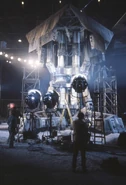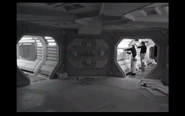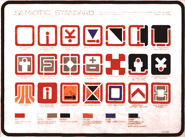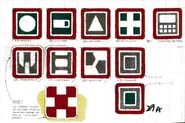Toa Quarax (talk | contribs) |
Toa Quarax (talk | contribs) |
||
| Line 104: | Line 104: | ||
Mk35andsymbol.png|A Mk.35 aboard the ''Nostromo''. |
Mk35andsymbol.png|A Mk.35 aboard the ''Nostromo''. |
||
Img4.jpg|The ''Nostromo'' orbiting above a planet.<ref>http://www.propstore.com/cms/nostromo-a-legend-born-and-born-again/</ref> |
Img4.jpg|The ''Nostromo'' orbiting above a planet.<ref>http://www.propstore.com/cms/nostromo-a-legend-born-and-born-again/</ref> |
||
| − | Aliens movie map pack 11.jpg|The ''Nostromo'' as it appears in the ''Aliens: Colonial Marines'' DLC map ''Nostromo''. Note the [[tracking |
+ | Aliens movie map pack 11.jpg|The ''Nostromo'' as it appears in the ''Aliens: Colonial Marines'' DLC map ''Nostromo''. Note the [[tracking device]]s on the table. |
</gallery> |
</gallery> |
||
| Line 114: | Line 114: | ||
Nos2symbols.png|Some of the symbols used in the ''Nostromo''. |
Nos2symbols.png|Some of the symbols used in the ''Nostromo''. |
||
</gallery> |
</gallery> |
||
| + | |||
Revision as of 16:24, 14 November 2013
The USCSS Nostromo was a Lockmart CM-88B Bison M-Class starfreighter registered to the Weyland-Yutani Corporation out of Panama.[1] The Nostromo operated as a tug, connecting to and pulling loads like a tractor truck rather than carrying those loads on board like a traditional freighter.
The ship was destroyed in 2122 when its engines were set to self destruct by Warrant Officer Ellen Ripley in an attempt to kill the lone Xenomorph that had gotten loose aboard the vessel. The ship and its cargo were completely destroyed in the resulting explosion.
Overview
The Nostromo had three pressurized decks and four internal cargo holds, totalling around 1.1 million cubic meters of pressurized volume.[2] Most of the spare space on board was filled with fuel for the ship's fusion reactor and reaction mass for the thrust engines.[1] The upper deck contained the main living areas, including the bridge, crew quarters, mess hall, science station and medical bay, while the lower decks comprised of extensive engineering and storage areas.[3] The ship was sturdy enough to withstand atmospheric re-entries and had three main landing legs to allow surface landings. Particulate shielding helped to protect the vessel from airborne debris in even the roughest planetary atmospheres.
In-flight systems were governed by the ship's central artificial intelligence computer, MU-TH-UR 6000 (known by the crew as "Mother"). A backup 2.0 terabyte mainframe would come online should Mother fail, while a third tier of automation could sustain vital systems in the rare event of a failure in the backup CPU as well.[1] Despite the extensive computer automation aboard the Nostromo, a human crew was still required for more complicated docking manoeuvres at each end of a transit.
The ship was equipped with a light shuttle, the Narcissus, located in an external docking bay on the underside of the hull. This shuttle also doubled as a lifeboat in the event of an emergency, although it could only support two long-term passengers.[3]
Energy and propulsion
The Nostromo's power core was a Laretel WF-15 2.8 terawatt fusion reactor.[2] The power plant operated around a deuterium/tritium reaction that fused the fuel elements in a containment chamber using conversion lasers. The He4 byproduct of the reaction was stored separately and vented at regular intervals. Power was drawn off of the reactor by a closed-cycle liquid potassium cooling system, running off into an induction torus which used the intense magnetic field created by the superheated potassium to generate electric power for the vessel.[2]
Notably, the ship's reactor possessed a self destruct capability, whereby the reactor's coolant systems could be shut down leading to a runaway reaction in the containment sphere and eventual catastrophic detonation. Once the process was begun, there was a five-minute failsafe period during which time the coolant system could be successfully reactivated.[3] However, after this period had expired, the supercritical reaction became unstoppable and after a further five minutes the reactor would explode. Activation of the self destruct could only be carried out by an authorized crew member, and the procedure sequence was sufficiently complex to prevent accidental activation.
Faster-than-light travel was accomplished through a Yutani T7A NLS tachyon shunt drive, capable of propelling the Nostromo to a cruising speed of 0.42 light-years per sidereal day when the ship was unladen.[2] When towing large mass cargoes such as automated refineries, the maximum sustainable cruise speed drops significantly, to around 0.1-0.12 light-years per sidereal day.[2] For manoeuvring at sublight speeds while towing a large mass, the Nostromo was fitted with two immensely powerful Rolls-Royce N66 Cyclone thrust engines with bipolar vectoring for midline lift function. Each of these N66 cyclone powerplants developed 65,830 metric tons of thrust, using water for reaction mass. When running at full power, the engines produced a high impulse thrust total of 131,660 kN.[2]
Communications
The Nostromo had a standard communications set up, comprising 10 and 4 meter hyperstate antennas for any interstellar communications and UHF/VHF/HF radio/video links for short-range links. Navigational sensors were mounted on pylons clustered around the forward hull of the ship and included two 2 m aperture telescopes capable of optical, spectrographic and infrared resolution, a gas chromatograph, centimetric navigation and landing radar, a synthetic aperture ground mapping radar and a mass counter for supralight navigation.[2]
History
The Nostromo started life as an interstellar cruiser, but was refitted in 2116 as a commercial towing vehicle and was subsequently operated as a commercial hauler, transporting automated ore and oil refineries between outer colonies and Earth.[1] As part of this retrofit, the ship's original Saturn J-3000 engines were removed and replaced with the more powerful N66 Cyclone powerplants.[2] The seven hypersleep chambers that would accommodate the crew during long-duration flight were also installed at this time.
Final voyage
When Weyland-Yutani detected and partially decoded an unidentified warning signal emanating from LV-426,[4] the Nostromo was selected (unbeknownst to its crew) to investigate and hopefully recover a potential Xenomorph specimen from the moon. To help ensure the recovery of the creature, the Nostromo's science officer was replaced two days before the ship left Thedus with Ash, a Synthetic sleeper agent under secret company orders to assist in the recovery of a Xenomorph through any means necessary, even at the expense of the rest of the crew.
The Nostromo set down on LV-426 on 3rd June 2122.[1] The ship was damaged during landing when dust entered one of the engine intakes, causing it to overheat and eventually triggering an electrical fire in the engineering section.[5] When Executive Officer Kane was later brought back aboard the ship with a Facehugger attached to him, Captain Dallas elected to take off, despite the fact several non-critical systems had yet to be repaired.
Once under way, the Alien that birthed from Kane began stalking and slaughtering the crew, whose efforts at fighting the creature were hampered both by Ash and, more generally, by the fact it remained on the lower engineering decks, where the security camera systems were still inoperable following the electrical damage caused on LV-426.[3] Eventually the few survivors decided to set the ship for self destruct in an attempt to kill the Alien while they themselves escaped in the shuttle Narcissus. Only Ellen Ripley survived to make the escape, along with the ship's cat Jones, while the ship and cargo were completed destroyed by the detonation of the Nostromo's reactor.
Legacy
Following its destruction, the Nostromo incident was subject to a cover up. The Weyland-Yutani personnel who had given the ship its secret mission to LV-426 destroyed all records of ever having done so, along with any information regarding the emergency beacon being transmitted by the Derelict Ship.[6] The Derelict itself was later damaged by volcanic activity and its beacon went offline as a result.[7] In time, the loss of the Nostromo was relegated to the pages of history, until Ripley was rescued from deep space some 57 years later.
Crew
- Dallas Arthur — Captain
- Gilbert Kane — Executive Officer
- Ellen Ripley — Third Officer
- Ash — Science Officer
- Joan Lambert — Navigator
- Dennis Parker — Chief Engineer
- Samuel Brett — Engineering Technician
- Jones — Ship's cat
Behind the Scenes
The Nostromo's name was taken from the eponymous hero of the 1904 novel by Joseph Conrad. The ship was originally called the Snark, then later the Leviathan, before the production team finally settled for Nostromo.[8] People and places from Conrad's works would go on to feature repeatedly as the names of space-going vessels in the Alien franchise, inspiring the names of the Narcissus (also from Alien), the USS Sulaco (from Aliens), the Patna (from Alien3), the USS Verloc (from Aliens versus Predator 2), the USS Marlow (from Aliens vs. Predator) and the USS Sephora (from Aliens: Colonial Marines).
The Nostromo was originally painted yellow. However, after the model unit had spent several weeks filming the model, Ridley Scott decided to repaint the ship grey and reshoot all of the model work himself. The main Nostromo model, which was chiefly used for the landing sequences, was some 16 feet in length and weighed a quarter of a ton; it was so heavy that it had to be manoeuvred on a forklift truck, which would plug into two slots on the back of the model.[8] An additional 4 foot model was also used for several scenes. At one point, the refinery being towed by the Nostromo featured towering spires considerably higher than those that appear in the final film, but just before filming Ridley Scott personally removed the upper sections (allegedly with a hammer and chisel).[8] The release mechanism that secures the Nostromo to the refinery actually featured the legs of R2-D2 as decorations on its upper surface.[8]
The interior set of the Nostromo constructed for filming was all interconnected and largely sealed, meaning cast and crew had to walk through the various corridors and chambers to reach other areas of the ship. Several crew members commented that the confines of intricate set meant filming was more akin to shooting on location than in a studio, and that the interior's enclosed nature helped to create a feeling of claustrophobia appropriate to the film.[8] Much of the interior was dressed with various aircraft parts, acquired by the production team from RAF stock that was being decommissioned at the time.[8] Just before filming, Ridley Scott had the production crew drop the ceiling of the originally spacious bridge set by some 4 feet, creating that far more enclosed space seen in the film.[9]
Trivia
- One of the opening scenes of Alien shows the computer waking-up, after which a console reads "CAPACITY. 200 000 000 TONNES". This means that, even with the weight of the refining equipment factored on top of the load of ore, the Nostromo was likely not hauling its full potential capacity.
- Some of the computer displays from the Nostromo were reused in Ridley Scott's later film Blade Runner.
- Some moviegoers mistake the refinery for the Nostromo, and have confused the Nostromo itself when it detaches from the refinery for the shuttle Narcissus. The refinery is never actually inhabited in the film, as even the Alien remained on the Nostromo itself.
- Originally, there was supposed to be an eighth member of the crew, a security officer called Fazio. He was scripted to be killed by the fully grown Alien not long after Kane's death while searching through the ship. However, the character was cut from the movie early in production.
Appearances
- Alien/novel/comic (First Appearance)
- Alien (1982 video game)
- Alien (1984 video game)
- Aliens/novel (mentioned only)
- Aliens: Colonial Marines Technical Manual
- Aliens: Colonial Marines (video game, mentioned and multiplayer only)
Gallery
Behind the scenes
External Links
- Prop Store - Alien - The Nostromo: A Restoration Project
- Prop Store - NOSTROMO: A LEGEND BORN AND BORN AGAIN
- Prop Store - NOSTROMO: A LEGEND BORN AND BORN AGAIN PART 2
References
- ↑ 1.0 1.1 1.2 1.3 1.4 1.5 1.6 Lee Brimmicombe-Wood. 'Aliens: Colonial Marines Technical Manual', p. 135 (1996), HarperPrism.
- ↑ 2.0 2.1 2.2 2.3 2.4 2.5 2.6 2.7 Lee Brimmicombe-Wood. 'Aliens: Colonial Marines Technical Manual', p. 136 (1996), HarperPrism.
- ↑ 3.0 3.1 3.2 3.3 Dan O'Bannon, Ronald Shusett (writers) and Ridley Scott (director). Alien (1986), 20th Century Fox [DVD].
- ↑ Alan Dean Foster. Alien novelization, p. 201 (1979), Warner Books, Inc..
- ↑ Alan Dean Foster. Alien novelization, p. 30 (1979), Warner Books, Inc..
- ↑ Lee Brimmicombe-Wood. 'Aliens: Colonial Marines Technical Manual', p. 143 (1996), HarperPrism.
- ↑ "Weyland-Yutani Archives - James Cameron's Responses To Aliens Critics". Retrieved on 2013-07-01.
- ↑ 8.0 8.1 8.2 8.3 8.4 8.5 Ridley Scott, David Giler, Walter Hill, H. R. Giger, Dan O'Bannon, Ronald Shusett. The Beast Within: The Making of 'Alien' (2003), 20th Century Fox [DVD].
- ↑ Ridley Scott, H. R. Giger, Dan O'Bannon, Ronald Shusett. Alien Legacy (1999), 20th Century Fox [DVD].
- ↑ http://www.propstore.com/cms/nostromo-a-legend-born-and-born-again/


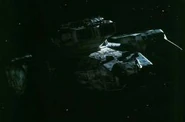
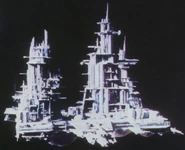
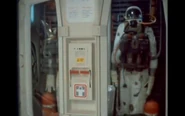
![Img4.jpg (111 KB) The Nostromo orbiting above a planet.[10]](https://static.wikia.nocookie.net/avp/images/c/c5/Img4.jpg/revision/latest/scale-to-width-down/177?cb=20131021025529)

